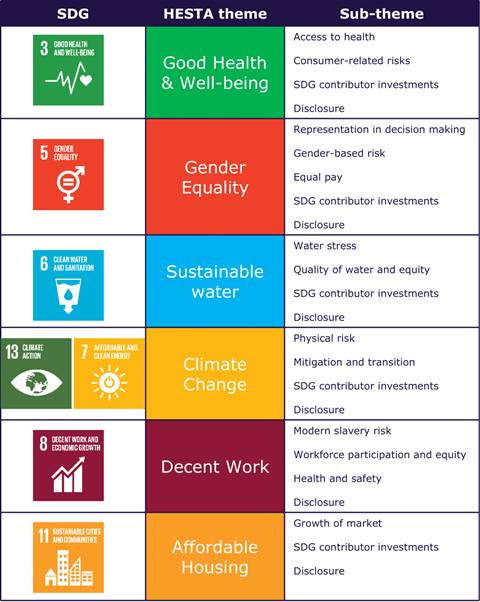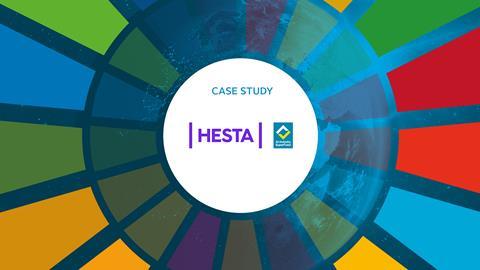HESTA
- Asset owner/investment manager
- Melbourne, Australia
- AUS$60 billion
This case study describes HESTA’s approach on how we have focused our responsible investment work on shaping SDG outcomes. In particular, the case study will explore our policy framework, impact measurement and management approach.
Why we focus on SDG outcomes
We decided in 2017 that as universal owners and long-term investors, the achievement of the SDGs is aligned with our fiduciary obligations. Further, it provides a framework to outline our global and local ambitions regarding a series of social and environmental issues that we believe are likely to affect member outcomes.
The board has identified six areas of focus, framed within seven SDGs. The selection criteria involved considering the priorities of our members, the portfolio exposures and the areas where we could most meaningfully contribute based on our position in the market. These six areas of focus are:
1. Health and wellbeing (SDG 3)
2. Gender equality (SDG 5)
3. Sustainable water (SDG 6)
4. Climate change (SDG 7 and SDG 13)
5. Decent work (SDG 8)
6. Sustainable cities (SDG 11)
Endorsement from the board was a catalyst for receiving buy-in from internal stakeholders. At that point, the responsible investment team transitioned to a role of advising the investment team on how to integrate these SDG themes through investment decision-making, advocacy and stewardship activities. Additionally, our Impact Committee was created as a sub-committee of the board to oversee our progress towards contributing positively to the SDGs.
How we focus on SDG outcomes
1. Aligning the responsible investment policy framework with SDG objectives
Our Responsible Investment Policy outlines the rationale for supporting the SDGs and the tools we have at our disposal to do it (i.e. proxy voting, company engagement, advocacy and collaborative work, risk-based exclusions and impact investments). To complement the policy, we have developed thematic statements that outline how we view the SDGs from a risk (system and company level) and from an investment opportunity perspective. These principle-based statements also act as expectation documents for our external investment managers and investee companies.
2. Measuring and tracking real world impact
We are developing the HIMA (HESTA Impact Management Approach). The HIMA applies at a total portfolio level: it captures all asset classes and aims to aggregate the impact of investment, stewardship and advocacy activities.
The HIMA identifies sub-themes, which are areas of measurement within each of our six SDG themes listed above. Each one of these will include outcome-oriented metrics or metrics that are proxies for outcomes. For example, for climate change, the desired outcome is to keep global warming at 2o C, and the metrics we could consider are Co2 emissions reduction and MW new renewable energy as proxies for the outcome. We also want our actions to have a direct positive impact on the healthcare sector where many of our members work and by reducing emissions, for example, we will help lessen the number of respiratory and cardiovascular illnesses caused by air pollution that the sector currently faces. We are in the process of establishing baseline metrics and expect to track performance on an annual basis and report them back to the Impact Committee.
While we do not currently have defined targets for each metric, we will seek a positive direction of travel. At times, we may decide that we require a higher level of ambition or speed to shift these metrics and we will set specific outcome-oriented targets. This was the case with climate change, where we decided to set an emission reduction target of 33% by 2030 and to align the portfolio to net zero emissions by 2050.
Example: Setting policy and monitoring progress
When it came to developing the thematic statements about risks and opportunities, we focused on our role as universal owners and long-term investors and the future we want our members to retire into. We considered three key principles:
- Prioritise system-level risk management: We focus on risk management at the system level and over a long timeframe (10+ years). We seek to filter down this thinking through our investment chain, including our investment managers and investee companies. At the operational level this means encouraging them to consider externalities that are likely to play out in the long term or that have deep implications to societies and the environment.
- Focus on outcomes: We outline our outcome-oriented approach and encourage the companies we invest in to track and be accountable for similar outcome-oriented indicators. For example, we communicate our carbon emissions reduction target of 33% by 2020 and aligning the portfolio to net zero emissions by 2050. This approach signals our expectations that managers and companies will help us achieve those commitments by setting carbon emission reduction targets themselves. With 80% of our membership being female, gender diversity is another important focus area for us. We encourage our managers and investee companies to set targets to increase female representation in leadership and on boards as research shows this leads to better decision-making and company performance.
- Collaborate: Our policy and statements outline the tools we use to achieve outcomes. This includes how we use voting, company engagement and advocacy in a strategic way. We recognise that we are only one shareholder amongst many and support the power of collaborating with others in the investment community to send unified messages for deeper impact.
Measuring and managing SDG outcomes
It is the responsible investment’s team role to integrate these policies into all of HESTA’s investment decision-making frameworks, stewardship and advocacy activities. Some of this implementation is done on a per project basis, as well as through collaboration with the investment community.
The following is an example of how we may track our annual contribution to real-world outcomes through our HIMA framework:

The selection of sub-themes is based on the SDG targets. They are determined based on how the products and services in the companies we invest in directly contribute to the targets under each SDG.
We recognise that the availability of adequate data to monitor progress of these metrics is limited, so we will monitor the level of disclosure for each metric and aim for improvement over time. While disclosure in itself is not an outcome metric, in combination with other outcome-oriented metrics, it tells a story about the impact we are having.












